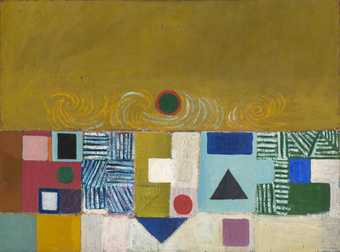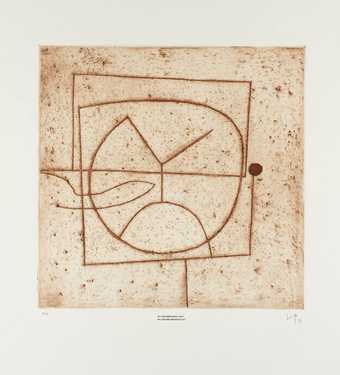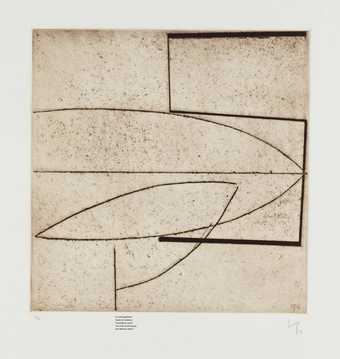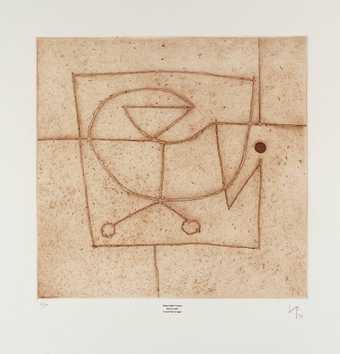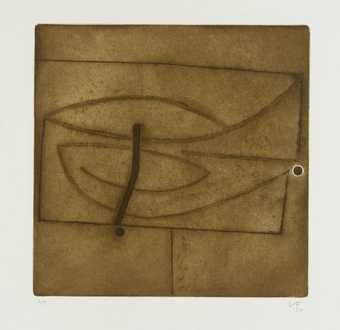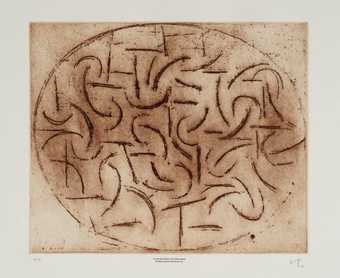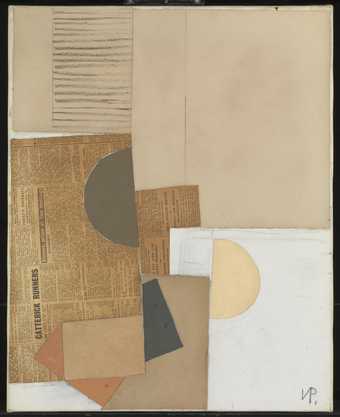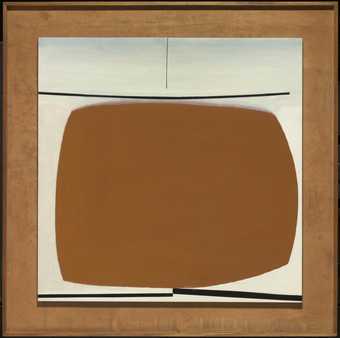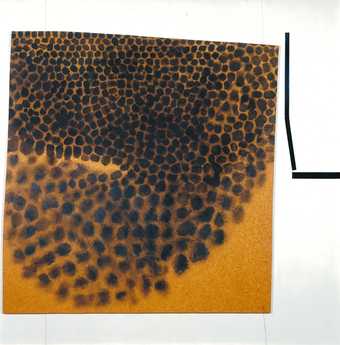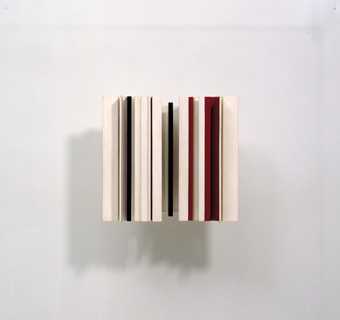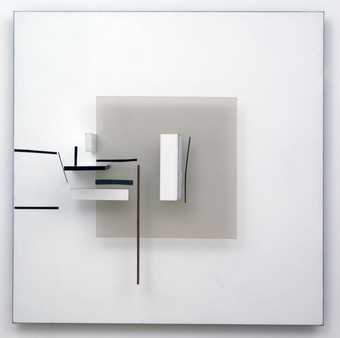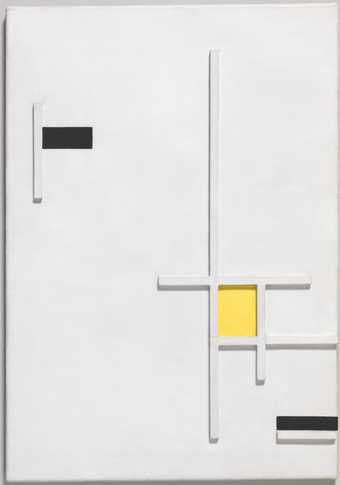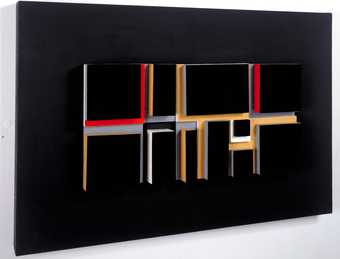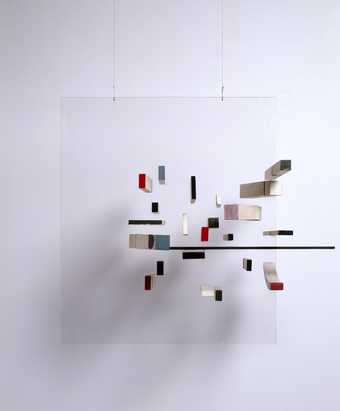
In Tate St Ives
- Artist
- Victor Pasmore 1908–1998
- Medium
- Painted wood
- Dimensions
- Object: 1067 × 1168 × 32 mm
frame: 1557 × 1527 × 144 mm - Collection
- Tate
- Acquisition
- Purchased 1958
- Reference
- T00166
Display caption
Pasmore believed that art derived from nature, and specifically from its underlying processes and structures rather than its surface appearance. In his reliefs Pasmore brought ideas of growth and abstract harmony into three dimensions. He rejected tilted elements because they were not organic developments of the rectangles in the way that horizontals and verticals are. He added: Geometry, though subject to the quoi of personal judgment, is a guide to the organic process.
Gallery label, August 2004
Does this text contain inaccurate information or language that you feel we should improve or change? We would like to hear from you.
Catalogue entry
Victor Pasmore 1908-1998
Abstract in White, Black, Indian and Lilac
1957
T00166
Painted wood 1067 x 1168 x 32 (42 x 46 x 1 1/4)
Purchased from the artist (Knapping Fund) 1958
Exhibited:
Victor Pasmore: Retrospective Exhibition 1925-65, Tate Gallery, London, May-June 1965 (131)
Henry Moore to Gilbert and George: Modern British Art from the Tate Gallery, Palais des Beaux Arts, Brussels, Sept.-Nov. 1973, as part of Europalia 73 Great Britain (65, repr. p.81)
Victor Pasmore 1950-1967, Musée des beaux-arts et de la dentelle de Calais, June-Oct. 1985 (9, repr. p.27 as Abstract in White, Black, Indian Red and Lilac)
Literature:
Tate Gallery Report 1957-8, London 1958, p.21
Alan Bowness, ‘The Paintings and Constructions of Victor Pasmore’, Burlington Magazine, vol.102, no.686, May 1960, p.205
Mary Chamot, Dennis Farr and Martin Butlin, Tate Gallery: The Modern British Paintings, Drawings and Sculpture, II, London 1965, p.511
Alan Bowness and Luigi Lambertini, Victor Pasmore, with a Catalogue Raisonée of the Paintings, Constructions and Graphics 1926-1979, London 1980, p.298, no.203, repr.
Reproduced:
John Rothenstein, The Tate Gallery, London 1962, p.262 (as Spiral Motif in green, Violet, Blue and Gold)
Alley 1966, pl.20
Abstract in White, Black, Indian and Lilac is made up of thirteen strips and blocks of wood laid onto a support of 5/8 in. blockboard. Twelve pieces of uniform length (about 13 inches), but of three different depths and varying widths, are arranged horizontally on either side of a vertical strip. This central vertical, the two adjoining horizontals and the large, red rectangle at bottom right project the least; the two elements on the same vertical level as each other, exactly half way up, one white and one black, are slightly deeper. The remaining elements all project further, to a uniform depth of about one inch, the rectangle in the top left hand corner being raised to this level on another slightly smaller block so there is a small overhang beneath. The black below it and a lilac area further down are painted onto the main board and serve as further elements in the composition. The various wooden components were glued or nailed on to the blockboard support; most of the nails are now visible and raised slightly above the painted surface. The main board was painted in white oil over a cream ground which is visible in some areas where it was not covered by the artist. Pencil drawing is evident around the other colours, which were applied on to the white. There was some accidental wiping of paint onto the sides of the vertical elements. The white paint also covers the front edge of an aluminum strip around the main board that is integral to the work. Though the work was acquired by the Tate as Abstract in White, Indian Red and Lilac, the artist wrote later that the title should be Abstract in White, Black, Indian and Lilac.[1]
Abstract in White, Black, Indian and Lilac is one of a number of similar constructions made by the artist between 1954 and 1958. Pasmore stated that Lawrence Alloway’s article, ‘Pasmore Constructs a Relief’,[2]
was ‘about an earlier version of this relief’;[3]
he later described the group of works as a ‘series’.[4]
Alloway wrote that these works were reproducible in editions of six or twelve but, in practice, Pasmore found it difficult to repeat a theme without introducing variations. The artist wrote that there was no other version of Abstract in White, Black, Indian and Lilac.[5]
Though the early reliefs were made by Pasmore himself, later works such as this were made by a professional joiner, working from a maquette, and painted by the artist.
Alloway’s article documented the conception and production of a relief, describing the way in which the artist, after making some rough sketches, began work with a few basic forms and criteria. Choosing as a format a rectangle from Jay Hambidge’s The Elements of Dynamic Symmetry,[6]
Pasmore built up a relief using ‘bits and pieces’ selected from ‘a heap of hardboard, plywood, rods, plastics, piled against the wall’. His raw materials were a large white board, another slightly smaller, a sheet of glass of the same size and a number of nine inch strips of wood and plastic of different colours. Despite the relief’s rigidly rectilinear forms and the use of geometrical principles, Alloway sought to stress the importance of intuition and improvisation in Pasmore’s working methods. His first drawings were ‘made by eye and experience’ and ‘examined for mathematics’ later, so that the completed work combines objective principles with the artist’s subjective input. According to Alloway, Pasmore described this as an organic method of composition, by which he meant: ‘of or pertaining to an organized system’. He had rejected tilted elements in the relief because they ‘were not organic developments of the rectangles in the way that horizontals and verticals are. Geometry, though subject to the je ne sais quoi of personal judgement, is a guide to the organic process.’
The improvisatory production method ensured that the relief chronicled by Alloway had many forms before its final manifestation. The nine inch elements were arranged on the white board in different combinations of vertical and horizontal configurations, with the glass plane sandwiched between them. The final state was arrived at by the gradual rejection of a number of the component parts, until the flattest, simplest form was achieved. Later, having seen the photographs of the work in progress, Pasmore wrote to Alloway: ‘I have decided to construct all the stages independently as separate reliefs. The last version, therefore, will be simply a variation on the others’.[7]
An early form of the relief, with the strips of wood arranged vertically on the glass plane, provided the basis for one of Pasmore’s most repeated type of work, of which Relief Construction in Black, White and Maroon
(Tate Gallery T00609) is a late example.
Like the relief discussed by Alloway, the almost square proportions of the main board in Abstract in White, Black, Indian and Lilac were derived from a rectangle described by Hambidge. As Alloway explained, it was generated by the drawing of a circle within a square and a pentagon within the circle, the base line of the pentagon marking the point at which the square should be cut. The proportions of that rectangle also defined the size of the individual elements of the inner form. The ends of the vertical element, which is 24 inches long, and its two adjoining horizontal strips mark out a notional rectangle of the same proportions as the main support. The other pieces have then been moved horizontally beyond the bounds of that rectangle. That movement and the differing colours employed explore the ambiguities of pictorial space. This duality is made all the more obvious by Pasmore’s use of a disrupted symmetry. The two sides of the arrangement appear to be reflections of each other, but in fact are reversed vertically as well as horizontally, as if one side of the composition has been rotated through 180º. The colouring of the individual elements has also been changed, so that the large white rectangle in the top left hand corner is balanced by a similarly sized red one at bottom right, the painted lilac rectangle on the left equates to an unpainted area of white board on the right, and so on. The painted areas of lilac and black mean that there are eight elements on the left as opposed to six on the right, thus balancing the heavier dark rectangle in the bottom right hand corner.
Pasmore had made his first relief, a mural in Kingston-upon-Thames bus depot, in 1950 as part of his progression through a range of practices towards what he described as a more ‘objective art’. This first relief, of carved plaster, derived from the forms of his collages and drew upon his knowledge of Ben Nicholson’s painted reliefs. Though Pasmore made a number of constructed reliefs in the period 1951-3, most have been destroyed or substantially altered. The few surviving works and photographs of others show that they were largely made up of white-painted orthogonal pieces of wood, though they later included plastics. As well as developing from his own search for a concrete art, these were part of a body of works made by a number of British artists recovering the ideas of pre-war Constructivism. This group, of which Pasmore and Kenneth Martin were the dominant figures, included Adrian Heath, Mary Martin and Anthony Hill and gathered and exhibited at Heath’s Fitzroy Street studio. They adopted the name ‘Constructionists’, following the example of Charles Biederman, whose Art as the Evolution of Visual Knowledge was a significant influence from 1951.[8]
Specifically, Pasmore had welcomed Biederman’s text which, in its proposition of a new art based upon an examination of the history of art, echoed his own research. Both artists believed in art’s derivation from nature; but on its processes (‘structural processes’, in Biederman’s terms) rather than its forms. Biederman insisted on the obsolescence of painting since Mondrian, from whom his own work derived. In 1954 Pasmore also stated that painting’s two-dimensionality prevented it from developing the ‘real and organic’ relationship with space which was the goal of an objective art that was ‘logical and sufficient in itself’.[9]
To attain such an art, therefore, it was necessary for the artist to work in three dimensions.
Like Biederman, Pasmore conceived of relief as a point of transition between painting and sculpture. However, the choice of the term ‘abstract’ in the title, as opposed to ‘relief’, suggests that the series to which Abstract in White, Black, Indian and Lilac belongs represented his recommitment to pictorial space. In 1957 he explained the qualities particular to relief: ‘construction is a development of painting and not of sculpture. This is because sculpture, in spite of new developments, remains tied to mass. ... Abstract painting, being tied to area, cannot define space; only imply it. The necessity to define, rather than imply, space in the abstract demands a technique which is free both of mass and of surface’.[10]
The arrangement of flat forms in Abstract in White, Black, Indian and Lilac uses colour and composition to create illusions of space in contrast to the definition of actual space in more three-dimensional pieces. This is emphasised by the fact that the artist painted only the faces of the raised components. In this way Pasmore’s work belonged more to the tradition of Ben Nicholson’s paintings and reliefs than to that of Naum Gabo’s space constructions, for instance. The example of Mondrian obviously lay behind the work of the Constructionists; however works such as this are especially close to the shallow reliefs of Domela and Gorin (reproduced in Circle, 1937[11]
and in Biederman’s Art as the Evolution of Visual Knowledge) and those made by Marlow Moss, an English follower of Mondrian, in the 1940s. An exhibition of Moss’s reliefs, which include raised narrow strips comparable to the central element of the Pasmore relief, was held at the Hanover Gallery in 1953. Pasmore’s concern with the relationship between colour and space creation in constructions like Abstract in White, Black, Indian and Lilac also associated them with the work of contemporary painters such as Patrick Heron and Roger Hilton.
The revival of Constructivism was in contrast to the neo-romantic spirit which was thought to have dominated British culture in the 1940s. It was part of a broader recovery of pre-war Modernist art and reflected the resurgence of artists and ideas associated with the Bauhaus, relocated in America. The Museum of Modern Art, New York’s book Bauhaus 1919-28 (1938) had been one of a range of art historical and theoretical texts read by Pasmore at Camberwell School of Art in the 1940s. His Bauhaus-derived teaching regime at Durham University, like the predominance of organic process in his work, reflected Pasmore’s absorption of d’Arcy Thompson’s On Growth and Form (then widely read).[12]
The prominence given to organic principles in the production of these reliefs represented an important conjunction of the Constructionists, artists associated with the Independent Group and those more painterly abstract artists who later became known as Tachists and action painters. In 1953 Herbert Read related geometrical abstraction to the post-war situation, commenting upon the use of ‘geometrical proportions which are common to forms of organic life as well as to the forms of art - the so-called Divine Proportion etc. - and those invariable qualities of harmony and serenity to which mankind returns after every period of storm and stress’.[13]
[3] Letter to Tate Gallery, 22 Jan. 1958
[4] Letter to Tate Gallery, 18 March 1958, Tate Gallery cataloguing files
[5] Letter to Tate Gallery, 22 Jan. 1958
Explore
- abstraction(8,615)
-
- from recognisable sources(3,634)
-
- organic(827)
- non-representational(6,161)
-
- geometric(3,072)
- formal qualities(12,454)
-
- space(177)
- growth(36)
You might like
-
Victor Pasmore Square Motif, Blue and Gold: The Eclipse
1950 -
Victor Pasmore ‘Am I the Object Which I See?’
1974 -
Victor Pasmore ‘By What Geometry Must We Construct the Physical World?’
1974 -
Victor Pasmore ‘Deep inside I looked’
1974 -
Victor Pasmore Linear Development in One Movement
1974 -
Victor Pasmore Turning and Turning in the Widening Gyre
1974 -
Victor Pasmore Abstract in White, Grey and Ochre
1949 -
Victor Pasmore Linear Motif in Black and White
1960–1 -
Victor Pasmore Yellow Abstract
1960–1 -
Victor Pasmore Black Abstract
1963 -
Victor Pasmore Relief Construction in White, Black and Maroon
1962–3 -
Victor Pasmore Synthetic Construction (White and Black)
1965–6 -
Marlow Moss Composition in Yellow, Black and White
1949 -
Mary Martin Black Relief
1957–c.66 -
Victor Pasmore Abstract in White, Green, Black, Blue, Red, Grey and Pink
c.1963

